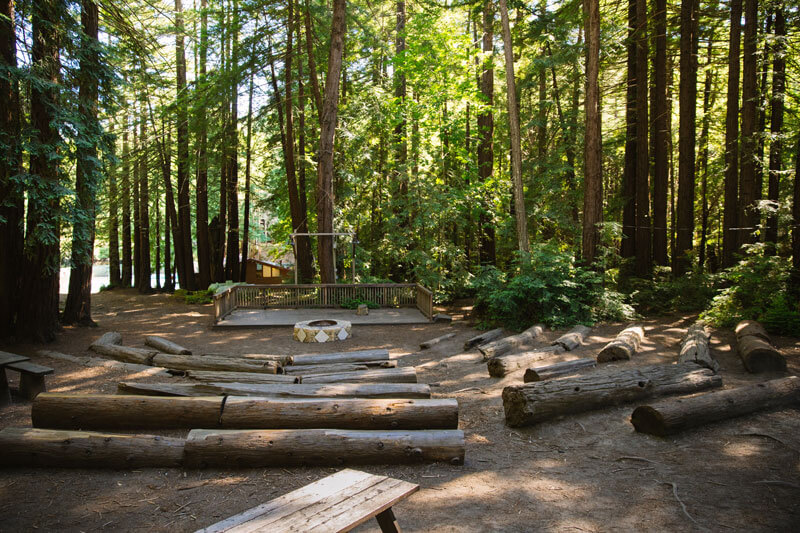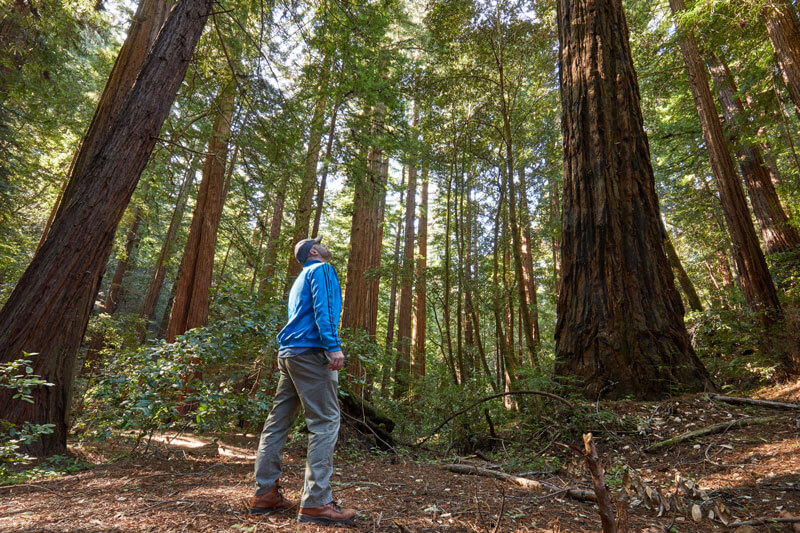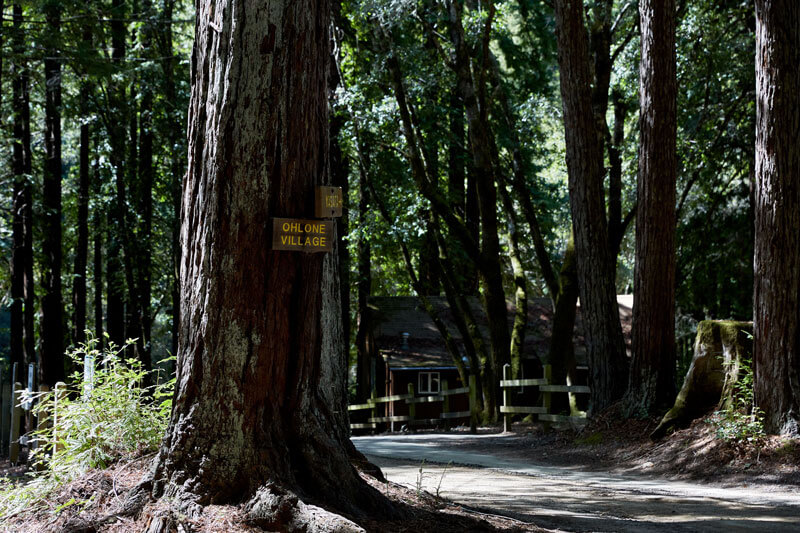Protecting Camp Jones Gulch
photo by Canopy Dynamics.
Hundreds of Acres and Heaps of Habitats
From the mighty old growth redwoods of the “Valley of the Giants” scraping the sky with their leaves right down to the roots of the grasslands, Camp Jones Gulch’s 920 acres are extraordinary and essential for protecting and connecting a healthy habitat in the Santa Cruz mountains. Although its habitat classifications could be expanded or collapsed, Laura McLendon, Director of Land Conservation for Sempervirens Fund, describes the land at Camp Jones Gulch in 7 different ecosystems.
photos by Michelle Kubik and Canopy Dynamics
Oak Woodland
Oak Woodland scattered over 37 acres provides canopy, acorns, and cover for black-tailed deer, western gray squirrel, band-tailed pigeon, rough-skinned newts, and San Francisco dusky-footed woodrat.
Douglas-Fir Forest
Douglas-Fir Forest featuring mature Douglas-firs, coast live oak, Pacific madrone, California bay, and California buckeye above an understory of ferns, California blackberry, pink honeysuckle, snowberry, and woodland strawberry dominate 433 acres of the property.
Coastal Scrub
Coastal Scrub, a mosaic of drought tolerant native plants like coyote brush, toyon, yerba santa, sticky monkeyflower, and California blackberry offer habitat to California quail, California towhee, white-crowned sparrow, peregrine falcon, brush rabbit, and gray fox, make up 91 acres.
Riparian Woodlands
Riparian Woodlands follow nearly nine miles of streams that flow into Pescadero Creek, important habitat for California giant salamander and rough-skinned newt, as well as spawning grounds for Northern Pacific tree frog, endangered coho salmon and threatened steelhead trout which produce their next generations and nourish both the forest and its creatures.
Coastal Prairie Grasslands
Coastal Prairie Grasslands filled with native grasses like purple needle grass, California oatgrass, and blue-eyed grass, crucial wildlife habitat and a diverse food source that have been disappearing at an alarming rate across the country, blanket 100 acres.
Redwood Forest
Redwood Forest made up largely of second and third-growth coast redwoods regrowing after clear cutting and later logging, with carpets of redwood sorrel, ferns, and redwood violets, shelter banana slugs, rough-skinned newts, and many birds like Steller's jay and Sawinson’s thrush in its snags, hollows, and logs, cover 192 acres.
Old-Growth Redwoods
Old-Growth Redwoods, including trees more than 500 years old, tower over 39-acres and may provide habitat for the endangered marbled murrelet which is known to fly from the sea to the area’s forests to lay their eggs in uppermost branches.
“It’s a surprisingly diverse property. We don’t usually encounter a property with so many ecosystems. It presents both a challenge and an opportunity,” McLendon explained. Camp Jones Gulch’s old-growth redwoods alone are unique because unprotected old-growth are rare in the Santa Cruz mountains she said, and when there are surviving old-growth they are usually much fewer and far between, scattered, making them more difficult to protect and without the more intact ecosystem that a larger forest like this provides.
Despite the innovative and wildly popular camp whose facilities are tucked into these diverse ecosystems, 90% of the property will be deemed the “Conservation Zone”. That means 835 acres of Camp Jones Gulch will be protected from commercial, industrial, or residential development forever through the conservation easement.
Conserving the Camp
A conservation easement protects the land and its natural resources from being depleted or developed forever. A conservation agreement can be a win-win solution for conservationists and landowners to protect the land while the landowner continues to own it. Sempervirens Fund has entered into an agreement to purchase a conservation easement on Camp Jones Gulch’s 920-acres to protect its forests, creeks, plants, and wildlife forever. The purchase of the conservation easement provides Camp Jones Gulch with funds to improve facilities and access for youth outdoor education, and a partner in caring for the nature that has inspired youth for generations. In addition to protecting Camp Jones Gulch’s phenomenal diverse ecosystems and old-growth redwoods, the partnership allows Sempervirens Fund the opportunity to help restore its health and enhance its resilience in the face of climate change and the increased threats, like major fire, it brings. “This conservation easement will protect the forest forever from fragmentation and it will give a mandate for ongoing stewardship. We are bringing resources and experience to help tend the forest that has been so integral to a million youth,” McLendon said.

Camp Jones Gulch won’t be the first youth outdoor education-based camp Sempervirens Fund has protected through a conservation easement. In 2012, Sempervirens Fund worked with the Girl Scouts of Northern California, whose goals of environmental outdoor education and preservation align with ours, to purchase conservation easements on two of their camps, Camp Butano Creek and Skylark Ranch, permanently protecting more than 400 acres, 1,400 old-growth trees, and providing funds to keep both camps operating to provide outdoor learning opportunities to girls and young women across the San Francisco Bay Area and beyond. Like Camp Jones Gulch, both camps’ forests and the endangered wildlife habitat they provide were at risk of being logged and lost but through the conservation easement the land is not only protected but the owners are now connected to partners like the Santa Cruz Mountains Stewardship Network to proactively manage the land including projects to reduce hazard trees from CZU fire damage and fuels for future fire resilience.
What makes the Camp Jones Gulch conservation easement different is Sempervirens Fund’s support with stewardship. With more than 900 acres of diverse habitats to take care of at Camp Jones Gulch, it's the largest acreage camp in the Santa Cruz mountains. That amount of land with unique habitat needs requires more time and expertise than the camp staff have the capacity to care for. “This partnership is unique in that we get to collaborate and support YMCA with their stewardship needs,” said Beatrix Jiménez-Helsey, Natural Resource Manager who has been coordinating the stewardship plan which will help inform how to best care for the varied habitats protected by the conservation easement.
Stewardship Plan
The stewardship plan compiles expert data on the property’s ecosystems, geology, soils, watersheds, and history to determine the best ways to care for the land including enhancing the health of the forest and wildlife habitats, and reducing the threat of fire. “We’ll be able to steward these forests into the future through the stewardship plan, through restoration projects, mentoring, and establishing a relationship with more sophisticated forest management for health and resilience in the face of climate change’s present and future threats like increased drought, heat waves, and catastrophic fires,” McLendon explained. Sempervirens Fund will create a $422,500 stewardship fund to monitor the easement and enhance and restore forest health, reduce the threat of wildfire, and promote climate resiliency across multiple wildlife habitats.

Forest and Fire
Long before it was a camp, the forests here had been clear cut over at least 192 of its acres in the early 1900’s. “We know this landscape was tended for millenia by Indigenous Peoples, and then there was an exploitation of resources here,” McLendon said. After the camp opened its doors, smaller amounts of logging called “selective timber harvests” were utilized in 1976 and 1985 to help fund the camp’s growing needs for outdoor education. But when the need arose again in the 2000's and The Y submitted new plans for logging, the opportunity to find an alternative solution that would be win-win for the camp and the forest that supported it became clear and talks to establish a conservation easement began.

This conservation easement though, would need to go beyond the status quo which often preserves the land and remains hands off. That type of approach is how the fuel loads of dense, overgrown and unchecked dry brush built up and entire forest areas grew back at the same time—the same age and too close together—after clear cutting. Older trees with more space between them and less dry plant matter on the ground are more resilient to fire. Redwoods are relatively resistant to fire thanks to thick tannin filled bark and canopies typically well above flames but drought, built up dry brush on the ground, and young trees close together have created conditions for fires to burn hotter and faster than even some of the native fire-adapted plants like redwoods can handle.
Each year, the fire season seems to get a little longer and fires seem to occur more frequently, hotter, and consume larger areas in the Santa Cruz mountains. And each year, The Y and Camp Jones Gulch staff worry the fires burn closer and closer to Camp Jones Gulch. Through the conservation easement’s stewardship plan, the land can be tended again with a combination of cutting-edge science and traditional ecological knowledge and techniques to better withstand the increased threats of drought, hotter temperatures, and increased fires that lie ahead.
Vegetation Removal
Stewardship projects like understory vegetation removal to clear away dry brush and fallen tree branches along the ground can greatly reduce the amount of fuel for a fire, helping to keep it from burning hotter and faster. Shaded fuel breaks, like the one that likely helped to decrease the heat and speed of the CZU fire on San Vicente Redwoods as it neared neighborhoods close by, place strategic gaps in the understory vegetation while the overstory trees shade the area keeping it cool, and damp with less regrowth to act like speed bumps to fire. With less fuel loads, there’s less dry plant matter for fire to grow and spread—helping diminish the intensity of wildfire, keeping fire from climbing up to tree canopies, and protecting Camp Jones Gulch and nearby communities.
Another type of plant removal that is crucial to forest health, biodiversity, and fire resilience is non-native species removal. Without natural checks and balances that develop in a species’ natural habitat, invasive species like clematis and French broom grow rapidly, overcome other species, and aren’t fire-adaptive, so wildfire can use them for fuel. Non-native species removal, such as removing the dead and aging non-native pines—whose resins already make them more naturally flammable—that were planted on a sunny ridge at Camp Jones Gulch will not only make the camp safer from natural disasters, but will also help to improve habitat for plants and wildlife. Removing invasive species in the creeks and pond of Riparian Woodland ecosystems will allow native plants to thrive and reduce erosion—too much soil getting into and clogging the water—which will boost aquatic habitat quality for all wildlife which depend on it, like the resident rainbow trout at the camp.
Restoration
While some plants like invasive species and abundant dry brush are important to remove from Camp Jones Gulch, other native plants are crucial to restore and renew habitat. The coast redwood trees like the “Valley of the Giants” on the property may be more impressive to behold and their heroics for holding more carbon dioxide than any other tree species better known, but a relatively unsung hero continues to grow much more humbly at Camp Jones Gulch. Grasslands in the region are hot spot ecosystems that provide food and habitat to many different species.
Grasslands feed and shelter many wildlife like western meadowlark, house finch, Say’s phoebe, California ground squirrel, and pocketgopher. These smaller birds and mammals in turn attract predators like red-tailed hawk, golden eagle, and American kestrel, coyote, grey fox, striped skunk, Pacific gopher snake, and various bats and swallows which come to hunt the smaller prey in the grasslands. Even below ground, these multitasking ecosystems are performing an imperative task—fighting climate change. “Native grasslands are great carbon sinks,” Jiménez-Helsley said. “Native grasses and forbs grow dense, fibrous roots containing carbon, and when the plant dies, the root biomass is trapped in the soil,” she continued, “where soil microbes will break down and consume some of the biomass, and the rest is sequestered.” Carbon sinks soak up carbon emissions, like CO2 from our cars, lessening their impact on global climate change. When the microbes die underground they too hold carbon in the soil and keep it out of the atmosphere.
The more we learn about native grasslands, the more we realize they are so much more than meets the eye. These crucial coastal grasslands across California, which mounting evidence points to being the result of careful tending by Indigenous Peoples over thousands of years, are now disappearing at an alarming rate. Without fires, grazing, and tending by people, these grasslands are quickly being overtaken by coastal scrub plants and the build up of dry plant matter on top of the soil called thatch not only prevents native plants from sprouting but is also highly combustible fuel that can allow fire to spread quickly and easily. However, the remaining coastal prairie grasslands at Camp Jones Gulch provide an opportunity to restore this critical habitat, support plant and wildlife in the area, and reduce fire danger. In fact, of the projects ahead, restoring the native grasslands is the one Jiménez-Helsley is most excited about. Like all of the projects led by the stewardship plan, experts will help guide the work to protect, restore, and care for Camp Jones Gulch’s precious natural resources.
Specialists for a Special Place
The conservation easement protects the amazing and diverse habitats of Camp Jones Gulch, helps to expand outdoor education for youth, and the partnership allows Sempervirens Fund to lead the stewardship plan development and coordinate experts on behalf of The Y to help carry out needed projects and care. “These 920 acres will have many hands to make it possible to enjoy and care for it in an ecologically mindful way” Jiménez-Helsley said. In addition to annual meetings with Camp Jones Gulch’s partners, The Y, camp staff, and the San Mateo County Office of Education who is instrumental in the camp’s outdoor education program, to ensure forest science is driving projects and decisions, Sempervirens Fund can also act as a conduit for potential regional collaborations. By working with organizations like San Mateo County Resource Conservation District and San Mateo County Parks, Sempervirens Fund can help bridge funding, permitting and implementation of projects at a regional landscape level for the health of the larger protected and connected landscape of forests, watersheds and wildlife corridors.
A conservation easement is forever, and the stewardship plan and partnership include an appropriately long-term vision. Sempervirens Fund brings land and stewardship expertise to the table and The Y brings outdoor education—allowing youth to connect with the land. “We’ve created a niche program of conservation easements on outdoor education youth camps. The missions compliment one another—creating future stewards who will care for and pass on these protected lands to future generations after us,” McLendon said. “We are repairing that past damage to reestablish a relationship with the land.” Much like the camp itself does for youth.

